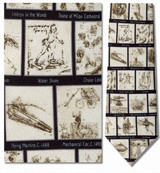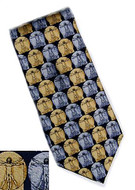- Home
- Art, Collectibles, Home & Decor
- Reliefs, Frescos & Wall Hangings
- Vitruvian Man Wall Plaque - Leonardo da Vinci circa 1487 - EXCLUSIVE
Vitruvian Man Wall Plaque - Leonardo da Vinci circa 1487 - EXCLUSIVE
Product Description
EXCLUSIVE for MUSEUM STORE COMPANY : The Vitruvian Man is on of the most famous and notable drawings and accompanying notes from Leonardo da Vinci';s journal entries of around 1487. It depicts a naked male figure in two superimposed positions with his arms and legs apart and simultaneously inscribed in a circle and square. Also know as the Canon of Proportions or the Proportions of Man. It is held in the Gallerie dell'; Accademia in Venice, Italy.
The Virtruvian Man provides insight into Leonardo';s keen interest in proportion. Leonardo believed the workings of the human body to be an analogy for the workings of the universe. According to the accompanying notes, the work was made as a study of the proportions of the (male) human body as described in a treatise by the Ancient Roman architect Vitruvius (Vitruvius De Architectura), who wrote that in the human body:
a palm is the width of four fingers & a foot is the width of four palms
- a cubit is the width of six palms & a man';s height is four cubits (and thus 24 palms)
- a pace is four cubits & the length of a man';s outspread arms is equal to his height
- the distance from the hairline to the bottom of the chin is one-tenth of a man';s height
- the distance from the top of the head to the bottom of the chin is one-eighth of a man';s height
- the maximum width of the shoulders is a quarter of a man';s height
- the distance from the elbow to the tip of the hand is one-fifth of a man';s height
- the distance from the elbow to the armpit is one-eighth of a man';s height
- the length of the hand is one-tenth of a man';s height
- the distance from the bottom of the chin to the nose is one-third of the length of the head
- the distance from the hairline to the eyebrows is one-third of the length of the face
- the length of the ear is one-third of the length of the faceD
aVinci';s Vitruvian (Vetruvian, Vertruvian) drawing symbolizes the essential symmetry of the human body, and by extension, to the universe as a whole.
4.5 lbs, 13.5"H x 9.8"W x 0.5"D, Cultured Marble / Stone : Antique Stone Finish
 Loading... Please wait...
Loading... Please wait...









